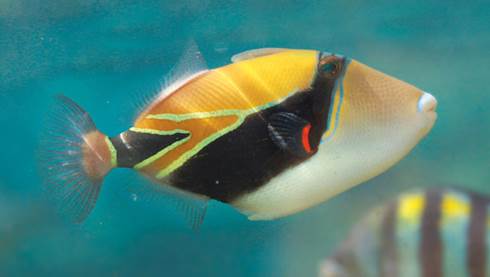In a store I saw a one-cup teapot
shaped like a fish I once met
under the waves at Puako Beach.
Short as a thumb, he had a name longer
than the curving shore. –from the poem, A Pot of Humuhumunukunukuapua’a, Rachel Dacus
I don’t pretend to know how to pronounce that – but the crib notes suggest “who-moo-who-moo-noo-koo-ah-pooah-ah”. It’s the Hawaiian name for the reef triggerfish, an ocean fish along the coasts of central and south Pacific Ocean Islands. The Hawaiian name translates to something like “triggerfish with a snout like a pig” or “fish out of the water that sounds like a pig”. It also is known as the wedgetail or Picasso triggerfish.
Rhinecanthus, from the Greek rhinos – nose, and akantha – thorn (possibly referencing the dorsal spine?), and rectangulus – referring to its shape.
If you are really interested in mastering the pronunciation you can sing along with Don Ho at 1:10 in this video https://www.youtube.com/watch?v=MWlvYpJ5pRo
This fish has a striking patter of dark and light colors on its sides and can be found at depths up to 20 feet. They have an orange snout and a bright blue band running over the upper jaw with a broad black or dark brown band extending diagonally across the body, running from the eye to the anal fin. There is a black triangle marking on the caudal peduncle (small part of tail) that faces forward.
They feed on corals and crustaceans using their strong teeth and jaws. They also forage on algae, detritus, mollusks, echinoderms, fish, sponges, eggs, and other items. They can blow jets of water from their mouth and can be found using this technique along coral at the seafloor, exposing potential prey. The group is called triggerfish because they can lock their first dorsal spine in place upright by the second spine – or trigger. These fish are generally about 10 inches long.
If approached they may immediately seek refuge in the coral or may become aggressive and swim right at the intruder, repeating a series of grunts. https://www.youtube.com/watch?v=MUtJqCpGXC8
Not much is known about their breeding cycles but they are oviparous (egg-laying) and young have been observed on reefs in the summer, suggesting a late winter spawning cycle. Females will tend the nest until hatching. They also are a popular aquarium fish. The reef triggerfish is pretty maneuverable using waving motions of its fins to move backward, forward, or hover above the reef. They may wedge themselves in the reef, sleep on their side, and use their dorsal spine to help hold them in place. They are pretty aggressive with other fish and the grunting noise has earned them their Hawaiian name.
In 1985 the triggerfish was voted the official State Fish of Hawaii but this designation expired in five years. So in 2006 the fish was reinstated as the official State Fish, this time permanently.
I’ve seen these fish in Kauai and recently while working in the Commonwealth of the Mariana Islands. The first week I was there was packed with meetings from 7:00 until 6:00, and then dinner meetings. Despite the hotel being within spitting distance from the water I never got my feet wet. It was pretty busy during our second visit but after a public evening meeting and before our afternoon strategy session we sneaked in a snorkel at the reef behind Bird Island – which is a marine refuge so no fishing is allowed. After a half mile walk through the forest and down the steep bluff via a permanent hand line we were at the beach watching the noddies circling in the air.
There was a fair chop but behind the island was sheltered and among the brightly colored fish I recognized the reef triggerfish, solitary and darting about the coral. It was quite the striking fish with the sun glinting off it sides, showing flashes of color, as it effortlessly accelerated around the reef.

